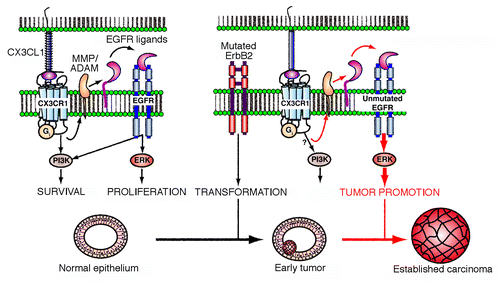Figures & data
Figure 1. CX3CL1 stimulates the progression of breast carcinoma. In mammary epithelial cells, chemokine (C-X3-C motif) ligand 1 (CX3CL1) favors the activation of epidermal growth factor receptor (EGFR) family members by stimulating the cleavage of membrane-tethered EGF precursors by ADAM matrix metalloproteinases (MMPs). This appears to activate the extracellular signal-regulated kinase (ERK) signaling cascade downstream of the CX3CL1 receptor (CX3CR1) in untransformed and neoplastic ERBB2+ cells. Although CX3CL1 is not needed for the development and physiological functions of the mammary gland, the CX3CL1-induced transactivation of EGFR plays a major role in the progression of early ERBB2+ breast carcinomas. This cell-intrinsic tumor-promoting activity of CX3CL1 might be associated with qualitative and/or quantitative changes in the strength, frequency or breadth of ERK-conveyed signals in transformed cells. However, established carcinomas become independent of this cross-activation circuit for progression. PI3K, phosphoinositide-3-kinase.
